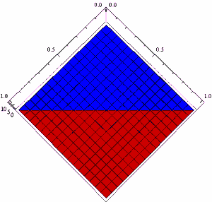You don’t need to be a rocket scientist to figure out that what the novelist Walter Mosley said about guns is true: “If you carry a gun, it’s bound to go off sooner or later.” Which is kind of obvious because after all, if you don’t carry a gun it can’t go off, right? But the trick, if you’re concerned about gun violence, is figuring out when and why a gun goes off, and once you know that, what to do about it. We seem to be much better at figuring out the when and the why, but an article published yesterday in the Journal of Public Health, may point a way towards also figuring out the what.
The authors, two Yale sociologists, Andrew Papachristos and Christopher Wildeman, have constructed a model for predicting gun violence based on studying gun homicides from 2006 to 2011 in an area of Chicago that had some of the highest rates of gun violence in a city that’s know for gun violence. The study found that 6% of the area’s population was involved in 70% of the murders, and nearly everyone in this population group had prior contact with criminal justice or public health. The data allowed the authors to construct a predictor of future gun homicides based primarily on social networks, a methodology that is now going to be used by the police to identify and visit with these high-risk kids and adults. As Papachristos puts it, “It’s who you hang out with that gets you into trouble.”
Papachristos and Wildeman are planning to extend their research to cover the entire city of Chicago, and perhaps the Chicago PD will be able to mount a citywide program to monitor the social networks that breed the violent use of guns. But the idea that guns are being used to commit violent crimes by people who know each other and band together is hardly new. In fact, it’s not only humans who behave this way - the same type of behavior can be found in animals and even insects, and this has been known for nearly a hundred years.
Back in the 1920s a statistician named Alfred Lotka and a mathematician named Vito Volterra developed a statistical analysis (known as the Lotka-Volterra equations) that are used by ecologists to predict how different species occupy and protect their home territories. This equation was then picked by a UCLA anthropologist, Jeffrey Brantingham, to study the territoriality of street gangs in Los Angeles and the links between each gangs’ territorial imperatives and gun violence. What Brantingham found was that the further away from the gang’s headquarters, the less gun violence was committed by members of each gang. The closer to the gang headquarters, the more shootings took place. The behavior of the gangs was no different from the behavior of hyenas or bees. Want to avoid being attacked? Stay away from the place where the guys with the guns are found.
The research just published by Papachristos and Wildeman defines gun violence territory not from a geographic, but from a social network perspective. It’s not about which street you walk on, it’s who you hang out with that predicts whether you’ll get shot or use a gun to shoot someone else. But when all is said and done, aren’t the findings by Papachristos and Wildeman on the one hand, and Brantigham on the other, really two sides of the coin? After all, people tend to spend their time with people they know. Call them a ‘group,’ a ‘gang’ or whatever, the tendency of humans to associate with one another in an organized manner is as old as humanity itself. It also seems to be as old as the existence of all living species. Maybe the cops should spend a little less time giving out parking tickets and spend a little more time at the zoo.
Related articles
- Gun Violence Significantly Increased by Social Interactions (usnews.com)
- Study finds social networks are key to city violence (eurekalert.org)

Recent Comments